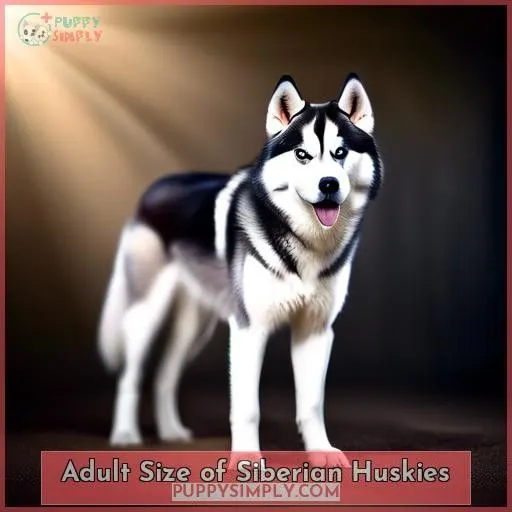This site is supported by our readers. We may earn a commission, at no cost to you, if you purchase through links.

Huskies stop growing at different ages based on their gender.
Generally, female Huskies reach their full adult size between 12 to 15 months of age.
Male Huskies tend to grow slightly larger and continue growing until around 18 to 24 months old.
The average height for a female Husky is around 20 to 24 inches at the shoulder, while males are typically 22 to 28 inches tall.
In terms of weight, a female Husky usually weighs between 35 to 60 pounds, whereas males can range from 45 to 85 pounds when fully grown.
It’s important to note that these are just general guidelines, as individual growth rates can vary based on factors like genetics, nutrition, and overall health.
Responsible owners should monitor their Husky’s growth and consult with a veterinarian to ensure proper development and maintain a healthy weight throughout their lifespan.
Table Of Contents
- Key Takeaways
- Siberian Husky Growth Stages
- Recognizing Full Maturity in Huskies
- Husky Size at 6 Months
- Factors Influencing Husky Growth
- Adult Size of Siberian Huskies
- The Role of Paw Size in Growth Prediction
- Timeline for Husky Weight Gain
- Transition From Puppy to Adult Coat
- Husky Eye Color Development
- Maintaining a Healthy Husky Weight
- Conclusion
Key Takeaways
- Huskies reach their full adult size between 12 to 15 months for females and 18 to 24 months for males.
- Female Huskies typically weigh between 35 to 60 pounds and stand 20 to 24 inches tall, while males weigh between 45 to 85 pounds and stand 22 to 28 inches tall.
- Siberian Huskies undergo distinct growth stages from birth to adulthood, with rapid growth in the first 6 months, gradual growth from 6 to 12 months, and reaching full size between 12 to 24 months.
- Proper nutrition, exercise, and veterinary care are crucial for maintaining a healthy Husky throughout their lifespan.
Siberian Husky Growth Stages
Siberian Huskies undergo distinct growth stages from birth to adulthood. During the first 6 months, they experience rapid growth, followed by a more gradual increase in size from 6 to 12 months, and finally reaching their full height and weight between 12 to 18 months of age.
Birth to 6 Months
As a young Husky, you’ll experience rapid growth in your first six months. During this period, your weight will increase considerably, and you’ll start to fill out. At six months old, you can expect to weigh between 30 and 40 pounds if you’re male, and between 25 and 33 pounds if you’re female. Your height will also grow, with males reaching around 14 to 17 inches tall and females around 13 to 16 inches tall.
The size of your paws can give an indication of your adult size. As a puppy, your paw size will be smaller, but it will grow as you do. By the time you’re fully grown, your paws will be proportionate to your body size.
Your coat will also undergo changes during this time. Initially, you’ll have a puppy coat that resembles fluff. Around 10 months of age, your puppy coat will start to shed, revealing your adult coat. By the time you’re one year old, your coat will be complete, and you’ll require regular brushing to maintain it.
Your eye color will also change during this period. All Huskies are born with blue eyes, but these will gradually change to your designated eye color, which is determined by genetics. Eye color changes can occur until you’re around 6 months old.
As you grow, your weight will continue to increase until you reach your full size. This usually happens by the time you’re 1.5 years old. Males will typically weigh between 21 and 23.5 inches tall and 45 to 60 pounds, while females will be around 20 to 22 inches tall and 35 to 50 pounds.
6 to 12 Months
During the second stage of your Siberian Husky’s development, from 6 to 12 months, you can expect significant growth spurts and size fluctuations. This phase is essential for your puppy’s early development, as they continue to grow in size and strength. Here are four key issues to address during this period:
- Weight Control: Make sure your Husky is receiving a balanced diet rich in protein and fat to maintain muscle mass and provide energy. Monitor their weight regularly and adjust their diet as needed to prevent obesity.
- Growth Spurts: Your Husky may experience rapid growth between 2-6 months, which can result in increased hunger, energy, and sleep. Be aware of these growth spurts and adjust their diet and exercise routine accordingly.
- Nutrition: Provide a balanced diet that meets your Husky’s nutritional needs, including essential macronutrients like protein and fat, as well as micronutrients. Consult with a veterinarian to ensure your Husky’s diet is appropriate for their age and size.
- Exercise: Regular exercise is vital for your Husky’s overall health and well-being. Make sure they receive adequate physical activity to support their growth and development.
12 to 18 Months
During the 12 to 18 month period, your Siberian Husky will continue to grow and develop. This stage is marked by a slowing of growth rate, as your Husky moves in the direction of its final size. At 12 months, your Husky will have reached about 50% of its final size. By 15 months, females will have reached their full size, while males may continue to grow until 18 months.
During this time, your Husky will experience weight fluctuations, as its bones develop and its muscles grow. The growth rate can be influenced by environmental factors, such as diet and exercise. Genetic factors also play a role in determining your Husky’s final size.
It’s essential to provide your Husky with a balanced diet and regular exercise during this period to support its growth and development. Overfeeding or underfeeding can lead to health issues and affect your Husky’s final size.
Recognizing Full Maturity in Huskies
To recognize when a Siberian Husky has reached full maturity, you’ll need to observe both physical and behavioral signs. Physically, the dog will stop gaining significant height and weight, appearing proportional and well-muscled; behaviorally, you may notice a calmer demeanor and a keenness to lead or assert dominance over younger dogs.
Physical Development
At what age do Huskies stop growing?
Siberian Huskies typically reach their full height by their first year.
Filling out, or gaining their adult weight, can take a few more months.
Most Huskies will be within the AKC size ranges:
- Males: 21-23.5 inches at the withers and 45-60 pounds
- Females: 20-22 inches at the withers and 35-50 pounds
However, size genetics can vary, resulting in smaller or larger individuals.
Factors such as genetics, paw size, nutrition, exercise, and lifestyle changes can influence a Husky’s growth and size.
Regular veterinary care, dental care, joint health, socialization needs, mental stimulation, and obedience training are essential for maintaining a healthy Husky.
Behavioral Signs
As your Siberian Husky grows, you’ll notice changes in their behavior that indicate full maturity.
They’ll become more socially stable and easier to train.
Their energy levels will stabilize, and their temperament will become more consistent.
By 15 months old, they’ll have reached their full height and weight.
However, their coat will continue to change until around 12-14 months, and they’ll need regular grooming.
Keep an eye on their health, as Huskies are prone to certain injuries and diseases like hip dysplasia and cancer.
Husky Size at 6 Months
At 6 months old, a male Siberian Husky typically weighs between 30 to 40 pounds, while a female tends to fall within the 25 to 33 pound range. Regarding height, your 6-month-old Husky pup should stand around 14 to 17 inches tall, with the male usually being on the higher end of that range.
Average Weight
At 6 months old, your Siberian Husky’s weight should be around 34 pounds, with males typically weighing between 30 and 40 pounds and females between 25 and 33 pounds. This is an average weight, and individual Husky puppies may weigh more or less, depending on factors such as genetics, diet, and exercise.
Expected Height
At 6 months, your Siberian Husky will likely be between 14 and 17 inches tall and weigh 25-45 pounds. This is a pivotal period for size estimation, as it provides a sound indication of your Husky’s potential adult size. Bear in mind that size genetics can vary, and some Huskies may be smaller or larger than the average range.
Factors Influencing Husky Growth
The size and growth rate of a Siberian Husky are influenced by several key factors. Genetics play a significant role, as the size of the puppy’s parents can provide insight into its potential adult dimensions. Additionally, proper nutrition and an appropriate exercise regimen are essential for ensuring adequate growth and development.
Genetics
Genetics play a significant role in determining the size and growth patterns of Siberian Huskies.
Breeding programs aim to maintain a balance between genetic diversity and breed standards, which can influence the size of offspring. Inbreeding, while historically used to develop certain breed qualities, can lead to health issues and a reduction in genetic diversity.
Environmental influences also impact growth, as a well-balanced diet and regular exercise contribute to a healthy weight and size.
The Siberian Husky breed standard, established in 1932, provides guidelines for ideal size and proportions. Males range from 21 to 23.5 inches tall and weigh between 45 to 60 pounds. Females range from 20 to 22 inches tall and weigh between 35 to 50 pounds.
Nutrition
To guarantee proper growth and development in your Siberian Husky, it’s imperative to provide a well-rounded diet that addresses their unique nutritional requirements. Here are three key aspects to keep in mind:
- Protein: A high-quality source of protein, such as chicken, fish, or lamb, is indispensable for supporting muscle development and repair and sustaining a robust immune system. A diet lacking in protein can lead to muscle atrophy and a weakened immune response, which can adversely affect your Husky’s health and well-being.
- Fats: Fats are an essential nutrient that provides energy, insulation, and support for the nervous system. A diet rich in fat is necessary to sustain your Husky’s energy levels, especially during physical activities. Conversely, a diet deficient in fat can lead to exhaustion, reduced activity, and poor coat quality.
- Carbohydrates: Carbohydrates are a source of energy for your Husky, but they need to be consumed in moderation to avoid weight gain. A diet that’s excessively high in carbohydrates can lead to obesity, which can result in serious health problems such as diabetes and joint issues. On the other hand, a balanced diet that includes complex carbohydrates, such as sweet potatoes or brown rice, can provide the necessary energy for your Husky’s high activity levels.
Exercise
Exercise isn’t just a walk in the park for your Husky—it’s the cornerstone of growth. Striking the right balance in exercise frequency and intensity is essential. Too little, and your Husky might turn your sofa into a chew toy; too much, and you risk overexertion. Tailor exercise recommendations to their boundless energy and watch them thrive.
Adult Size of Siberian Huskies
You’ll find that male Siberian Huskies typically reach an adult height of 21-24 inches (53-61 cm) and weigh between 45-60 pounds (20-27 kg). Females are slightly smaller, standing at 20-22 inches (51-56 cm) tall and weighing 35-50 pounds (16-23 kg) when fully grown.
Male Husky Dimensions
Male Siberian Huskies are known for their distinctive characteristics, including their size, speed, and temperament. These dogs typically reach full physical maturity between 10 months and 18 months, with males often filling out more than females. At 6 months, a male Husky can weigh between 30 and 40 pounds and stand 14 to 17 inches tall.
The adult size of a male Husky is influenced by factors such as genetics, nutrition, and exercise. On average, a fully grown male Husky can weigh between 21 and 23.5 inches tall and 45 to 60 pounds. This weight range is influenced by the dog’s paw size, which can indicate its adult size.
Male Huskies are known for their speed and agility, making them excellent working dogs. They’re also known for their independent nature, which can make them more challenging to train than female Huskies. Their lifespan is typically between 12 and 15 years, with proper care and attention.
In terms of color, male Huskies can come in various shades, including brown, which is a recessive color. Brown Huskies are becoming increasingly popular, and breeders may intentionally breed two brown Huskies to produce a litter of all-brown puppies.
Female Husky Dimensions
Female Siberian Huskies typically weigh between 35 to 50 pounds.
They stand between 20 to 22 inches tall when measured from the shoulder.
However, individual variations can occur.
Some females may weigh less or more than this range.
The weight and height of a female Husky can be influenced by factors such as genetics, nutrition, and exercise.
It’s vital to keep an eye on your Husky’s growth.
Have a chat with a veterinarian if you have any concerns about their weight or size.
The Role of Paw Size in Growth Prediction
Paw size plays a vital role in estimating a Siberian Husky’s adult size. Here are five key points to bear in mind:
- Genetic Influence: Paw size is genetically linked to adult size, with larger paws often indicating larger adult dogs.
- Breed Differences: Different breeds have varying paw sizes, which can help estimate adult size.
- Growth Estimation: Paw size can be used as an early indicator of a pup’s potential adult size, although it’s not a perfect predictor.
- Considerations: Other factors like nutrition and exercise also influence growth, but paw size is a useful starting point.
- Age Factors: Paw size becomes a more reliable indicator as a pup ages, with adult size generally reached by 1.5 years.
Timeline for Husky Weight Gain
You’ll often see your Husky pup reach their full height around one year old, but they’ll continue gaining weight until they’re 18-24 months old. At 12 months, expect male Huskies to weigh 40-50 pounds and females around 35-45 pounds, with steady weight gain after that until they achieve their full adult size.
Weight at One Year
At one year, your Husky will have reached its final height and will start to gain weight.
A 1-year-old Husky typically weighs between 35-55 pounds. It’s important to maintain a balanced diet and exercise requirements to ensure healthy weight gain.
Regular check-ups with your veterinarian can help monitor your Husky’s growth and weight progress.
Puppy food should be gradually switched to adult dog food around this time.
Weight Beyond One Year
After your Husky’s first birthday, you’ll notice their weight begins to stabilize, but don’t be surprised by some weight variations.
Their diet has a substantial impact; a well-balanced nutrition plan is vital for maintaining a healthy weight.
Exercise influence can’t be overstated; it determines their muscle tone and overall well-being.
Genetic limitations play a role, so don’t expect your small dog to grow to massive proportions.
Prudent weight management during this time ensures your Husky remains as healthy and active as a fiddle.
Transition From Puppy to Adult Coat
You’ll notice your Husky’s puppy coat shedding around 10 months, revealing the thick, dense adult coat that requires more thorough grooming. The adult coat fully develops by 12-14 months, necessitating regular brushing to manage the heavy shedding and maintain a healthy, tangle-free fur.
Shedding Patterns
As your Siberian Husky progresses from a fluffy puppy to an adult, their coat will undergo significant transformations. Here’s a 4-item list to help you prepare for the grooming odyssey:
- Grooming Acclimation: Start brushing your Husky regularly during puppyhood to familiarize them with the grooming process.
- Brushing Frequency: Increase brushing frequency as your Husky grows, especially during shedding seasons when their coat becomes denser.
- Undercoat Maintenance: Regularly brush your Husky to remove loose undercoat hair and prevent tangling.
- Shedding Severity: Be prepared for heavy shedding, especially around the 10-month mark when the puppy coat begins to shed, revealing the adult coat.
Grooming Requirements
As your Siberian Husky changes from a fluffy puppy coat to an adult coat, grooming becomes a vital part of their care.
Begin brushing during puppyhood to accustom them to the process.
Huskies have a thick undercoat that sheds profusely, so regular brushing is essential.
Brushing methods vary depending on fur patterns, but grooming tools such as slicker brushes and undercoat rakes can assist.
Husky Eye Color Development
Huskies are known for their striking eyes, which can change color during their puppyhood. Here are some key points to understand about Husky eye color development:
- Genetics: Eye color in Huskies is determined by genetics, with blue eyes being the most common and distinct color. However, they can also have brown, green, amber, or bi-colored eyes.
- Puppyhood: All Huskies are born with blue eyes, which change to their designated eye color by 9-16 weeks of age. This color change is usually complete when they’re around 16 weeks old.
- Stability: As Huskies grow into adulthood, their eye color should stabilize, and it becomes less likely to change unless something causes it.
- Heterochromia: Huskies are known for the prevalence of heterochromia, which is a condition characterized by a difference in coloration of the iris between the two eyes.
- Health implications: Changes in eye color as an adult are usually an indication of an eye problem.
Maintaining a Healthy Husky Weight
You’ll want to monitor your Husky’s weight closely to avoid obesity, which can lead to various health issues. Maintaining an appropriate diet and providing ample exercise opportunities will help keep your Husky at a healthy weight throughout its life.
Identifying Overweight
To guarantee your Husky’s well-being, it’s essential to recognize overweight indications and maintain their optimal weight range.
Overweight Huskies may show a deficiency of energy, difficulty in movement, and a lack of a defined waistline.
Regularly compare their weight to the Husky growth chart and consult a veterinarian if concerns arise.
Body condition scoring can help evaluate your Husky’s health.
Diet and Exercise Tips
To keep your Husky’s weight in check, think of diet management as the chef’s special and exercise recommendations as the daily workout menu.
Tailor their meals to meet their nutritional needs, adjusting portions as activity levels ebb and flow.
Keep them active with a mix of sprints and marathons, ensuring they stay as fit as a fiddle and as nimble as a cat on a hot tin roof.
Conclusion
Observing your Husky’s growth milestones is essential for their well-being. By understanding at what age Huskies cease growing, you’ll recognize when they’ve reached full maturity and can adjust their care correspondingly. Proper nutrition, exercise, and veterinary guidance during their development stages will help your furry companion flourish and maintain a healthy weight throughout their lifespan.
















